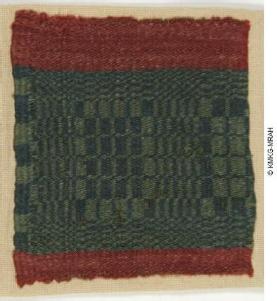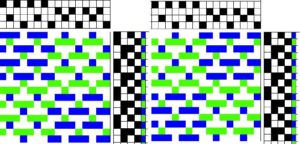Skip to content
Coptic Taquete
By Isabelle Fusey
Introduction
This paper is about my obsession with a taqueté fragment preserved in a museum in Belgium.
Figure 1 Coptic taqueté fragment, AD 500-700, ACO.Tx.2008 Musées royaux d’art et d’histoire1
This woven Coptic fragment, which is hundreds of years old and yet looks so contemporary, comes
from a textile probably woven by someone like me, someone practicing weaving as home craft and
looking for a way to accessorize her living room.
About taqueté
The story of taqueté goes back to the Roman Empire. Pliny the Elder himself had something to say about it. It is thought that taqueté was invented by tapestry weavers looking for a faster way to
produce weft-faced fabric, the speed of weaving mechanically selvedge to selvedge trumping design flexibility.
Taqueté is a weft-faced textile woven with two or more wefts of different colour. Taqueté goes by many names. Pliny the Elder called it polymita and beginner weavers erroneously refer to it as summer and winter without tabby. Purists use the term weft-faced compound tabby. Yet others call it weft-faced summer and winter, weft-backed plain weave, 2-block tied double weave, polychrome summer-and-winter weft-faced weave, or two-tie unit with four-end blocks. Atwater coined the term stuffer rug or two-warp weaving and Tidball changed that to double-faced stuffer weave or warp stuffer system. To Scandinavian weavers it is known as double-binding and to Persian rug weavers Zilu.
The earliest example of taqueté in existence in the world, a wool sample found in Masada, dates from the 1st century BC (Vogelsang-Eastwood, 2018; Pritchard, 2014; Verhecken-Lammens, 2007). A silk dress dated 1st century AD was found in Marseilles (Wild, 1987). Taqueté, born in the Middle East, perhaps in response to the warp-faced silk textiles coming from China, eventually became adopted in China itself and beyond. Today, taqueté is used mostly for rug weaving and lends itself to shaftswitching and pick-up techniques.
Taqueté structure
Technically, taqueté is “weft-faced compound tabby”. It is threaded like summer and winter and woven on opposites with two contrasting colours on the same threading as summer and winter but unlike summer and winter it does not have a ground cloth. Inside of thinking of taqueté as summer and winter, it is best to think of taqueté as a weft-faced block weave that uses two warps and at least two wefts contrasting in value. One warp acts as the binding warp and the other warp creates the pattern. The binding warp weaves tabby. The pattern warp controls what weft colour appears on the surface of the fabric in a given block (the other weft appearing on the back of the cloth). The pattern warp does not show at all; it is an “inner” warp that does not interlace with the weft. When woven with two wefts, taqueté is completely reversible. Unlike summer and winter which has a tabby weft I. Fusey Tx.2008 3 and a supplementary weft, both wefts in taqueté are required to give the fabric its structure. These wefts are complementary.
Block A is threaded 1323 and Block B is threaded 1424. Four picks are required for each unit, that is, four picks are required to weave a solid multi-coloured line on both sides of the fabric:
 Figure 2 Taqueté draft (front and back)
Figure 2 Taqueté draft (front and back)
The ratio of binding warp ends to pattern warp ends in the recovered Coptic textile fragments is usually 1 to 1. However, a few fragments have a 1:2 ratio (1 binding warp end to 2 pattern warp ends). These paired warp threads work together and act as a single thread. They behave exactly the same way as the four warp threads in Atwater’s stuffer rugs. Some samples have been found where the proportion of pattern warp threads to binding warp threads varies within the cloth (VerheckenLammens, 2007).
The origin of taqueté
The theory is that the development of weft-faced Coptic taquetés was informed by the warp-faced silk fabric making its way from China to Egypt along the Silk Road. Since silk yarn was not yet readily available in Egypt, the local weavers in the 3rd century AD turned the draft as it were and used their I. Fusey Tx.2008 4 woolen yarn instead of silk. Therefore, the “turned” taqueté so popular today would in fact be the ancestor of the “real” taqueté. Later (7th to 10th centuries), Chinese weavers developed their own form of taqueté.
Egyptian explorations at the turn of the 20th century unearthed thousands of scraps, mostly wool, in rubbish heaps and cemeteries. Of those thousands of fragments, only a fraction is woven in taqueté. Moreover, simple textiles such as the Tx.2008 fragment are in fact rare. Most of the recovered taqueté textiles are highly decorated with plant motifs (e.g., palmettes), animals (e.g., lions), human figures, and geometric patterns such as rosettes, octagons and eight-pointed stars and would have been woven by highly skilled artisans toiling in the specialized weaving workshops of Alexandria and other such cities.

 Figure 2 Taqueté draft (front and back)
Figure 2 Taqueté draft (front and back)